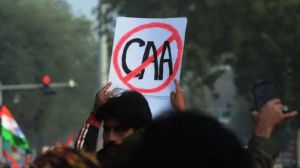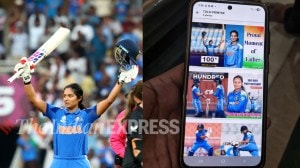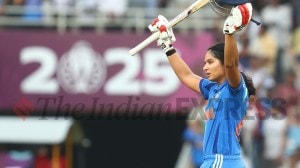🚨 The Indian Express UPSC Essentials brings to you the August edition of its monthly magazine. Click Here to read. Share your views and suggestions in the comment box or at manas.srivastava@indianexpress.com🚨
The Editorial Page
UPSC Syllabus:
Preliminary Examination: Current events of national and international importance
Mains Examination: GS-III: Security
Story continues below this ad
What’s the ongoing story- Manpreet Sethi writes— “Within 15 months of its nuclear tests – Pokhran II — India was ready with a draft nuclear doctrine. On August 17, 1999, K Subrahmanyam, convenor of the first National Security Advisory Board (NSAB), a subsidiary body of the National Security Council, presented the document to Brajesh Mishra, the country’s first National Security Advisor.”
Prerequisites:
— What is India’s Nuclear doctrine?
— India’s nuclear power programme
— Which countries in the world have nuclear weapons?
Key takeaways:
— “The draft doctrine did not receive the official stamp. However, the principles mentioned in it were reproduced in a press note that the government released after the doctrine was operationalised in 2003.”
— “The draft nuclear doctrine transparently presented India’s conceptualisation of its role as a nuclear weapons state. It unambiguously declared a political role for nuclear weapons, directed the building of credible deterrence at the minimum level, and for a retaliation-only policy.”
— “Pakistan’s use of cross-border terror and China’s increasingly aggressive behaviour are certainly the two topmost security threats India faces. There is also the additional fear of the two countries coming together against India.”
Story continues below this ad
— “Some other technological developments merit greater attention instead. These include the ability to mount cyber attacks on nuclear command and control, the use of AI to neutralise retaliatory capability, and improved intelligence surveillance and reconnaissance (ISR) capability that could make India’s nuclear forces more vulnerable to first strike. These developments demand a focus on the survivability of the country’s nuclear forces. They do necessitate changes in numbers and command and control structures. However, such capability build-up does not require a change in the nuclear doctrine.”
— “A second doctrinal attribute that often causes debate is no-first-use. This is instinctively dubbed as a reactive strategy that cedes initiative to the adversary. Pakistan’s and China’s disruptive behaviour is considered by some as being encouraged by India’s lack of a “hard-nosed hawkish” first-use strategy.”
— “A first-use strategy needs to be supported with a credible striking capability that would obviate, or significantly minimise, retaliation. This, in turn, is contingent on a sophisticated arsenal of highly accurate nuclear delivery systems in large numbers, with good ISR that can locate and target the adversary’s nuclear forces. An effective BMD will also be required.”
Points to Ponder:
— What are the security threats faced by India?
— What are the arguments in favour and against the ‘No First Use’ (NFU) of nuclear weapons?
— What are the various global initiatives for nuclear disarmament?
Post Read Question:
(1) Consider the following countries: (UPSC CSE 2015)
1. China.
2. France
3. India
4. Israel
5. Pakistan
Story continues below this ad
Which among the above are Nuclear Weapons States as recognized by the Treaty on the Non-Proliferation of Nuclear Weapons, commonly known as Nuclear Non-Proliferation Treaty (NPT)?
(a) 1 and 2 only
(b) 1, 3, 4 and 5 only
(c) 2, 4 and 5 only
(d) 1, 2, 3, 4 and 5
Other Important Articles Covering the same topic:
Explained: India’s doctrine of Nuclear No First Use
UPSC Syllabus:
Preliminary Examination: Current events of national and international importance
Mains Examination: GS-III: Science and Technology; Achievements of Indians in science & technology; indigenization of technology and developing new technology; Awareness in the fields of Space
What’s the ongoing story- On August 16, a 120-tonne rocket, about five times smaller than India’s largest satellite launch vehicle, took off from ISRO’s Satish Dhawan Centre in Sriharikota, heralding a major milestone in the country’s space research. The Small Satellite Launch Vehicle (SSLV) can carry payloads weighing up to 500 kg.
Prerequisites:
— What is ISRO’s Small Satellite Launch Vehicle (SSLV)?
— What are ISRO’s various space launch vehicles?
— Read about the New Space India Limited (NSIL)
Key takeaways:
— In the past decade, the miniaturisation of satellites has enabled the entry of universities, corporates and even individual innovators in a field once dominated by large enterprises and state institutions such as ISRO and NASA.
Story continues below this ad
— The SSLV can prove to be a game changer for these micro and nano space stations. The launch vehicle can be assembled in less than a week by a much smaller team. With ISRO planning to transfer technology to private players, the country’s space sector is poised for a significant expansion.
— The utility of small satellites is increasingly expanding in a variety of sectors, including weather forecasting, communications, defence, urban planning and disaster management. They are also crucial enablers in the growing Internet of Things.
— With the SSLV and related endeavours, the government aims at a four-fold scale-up in the country’s stakes by 2033.
— India’s space policy, introduced in April last year, recognised the country’s need to transition from the ISRO-dominated ecosystem. At the same time, the policy took care to underline the premier agency’s enabling role in expanding the country’s footprint in the space economy.
Story continues below this ad
— The challenge now is to frame a regulatory mechanism that complements ISRO’s work, enables manufacturers of small satellites and rockets to unlock their potential while also making sure that the country’s welfare imperatives are not crowded out. The SSLV’s launch should be a prelude to conversations on such a mechanism.
For Your Information:
— ISRO’s Small Satellite Launch Vehicle (SSLV) is a three-stage Launch Vehicle configured with three Solid Propulsion Stages. It also has a liquid propulsion-based Velocity Trimming Module (VTM) as a terminal stage, which can help adjust the velocity as it prepares to place the satellite.
— Essentially, the aim behind SSLVs is to produce low-cost launch vehicles with short turnaround times and minimal infrastructural requirements. The SSLV can launch satellites weighing up to 500kg and accommodate multiple satellites.
— The Polar Satellite Launch Vehicle (PSLV) is the third generation of Indian satellite launch vehicles. first used in 1994…. It has also been called “the workhorse of ISRO” for consistently delivering various satellites into low earth orbits (less than 2,000 km in altitude) with a high success rate.
Points to Ponder:
— What are the benefits of SSLV?
— What is India’s space policy?
Story continues below this ad
— What are the opportunities and challenges of private sector participation in space missions?
— What are the initiatives taken by the government to promote the privatisation of the space sector?
Post Read Question:
Prelims
(2) With reference to the Small Satellite Launch Vehicles (SSLVs), consider the following statements:
1. It is a three-stage Launch Vehicle configured with three Solid Propulsion Stages.
Story continues below this ad
2. They can carry satellites weighing up to 1500kg and accommodate multiple satellites.
3. The aim behind SSLVs is to produce low-cost launch vehicles with short turnaround times.
4. It is known as “the workhorse of ISRO”.
Which of the statements given above are correct?
(a) 1 and 2 only
(b) 2 and 4 only
(c) 1 and 3 only
(d) 2 and 3 only
Mains
Discuss India’s achievements in the field of Space Science and Technology. How the application of this technology has helped India inits socio-economic development? (UPSC CSE 2016)
Other Important Articles Covering the same topic:
After launch success, ISRO says SSLV development is complete
ISRO launches SSLV: What is the aim behind developing Small Satellite Launch Vehicles?
Story continues below this ad
Explained
UPSC Syllabus:
Preliminary Examination: Current events of national and international importance
Mains Examination: GS-II: Government policies and interventions
What’s the ongoing story- About four decades ago, Apple was just an upstart. It was up against the ‘big brother’ IBM – and it captured that in an iconic advertisement aired in ‘1984’. Then in 1999, an antitrust judgement against Microsoft halted its growing empire and opened doors for another upstart at the time, Google, to expand its web search business.
Prerequisites:
— What is the Digital Competition Bill, of 2024?
— What is antitrust?
— What is the EU’s Digital Markets Act (DMA)?
Key takeaways:
— Google is a “monopolist,” a federal judge in the United States held earlier this month, saying that the company acted illegally to maintain a monopoly in online search – a landmark judgement that strikes at the heart of online empires that have conjured up a significant part of the public Internet, and could potentially alter the way digital businesses behave.
— There are multiple antitrust challenges against the likes of Apple and Microsoft in other jurisdictions, all sharing largely the same premise – that these companies have become so big on the Internet that entry barriers for new companies are at an all-time high.
— It took the United States four years to bring a case against Google which eventually culminated in the landmark ruling against the company.
— Taking a leaf out of the European regulatory handbook, India has proposed a new digital competition law that could stop tech giants like Google, Facebook, and Amazon from self-preferencing their own services, or using data gathered from one company to benefit another group company.
— The draft law, called the Digital Competition Bill, 2024, also has provisions to set presumptive norms to curb anti-competitive practices before they actually take place, and promises to impose heavy penalties — which could amount to billions of dollars — for violations.
— The proposal is similar to the EU’s Digital Markets Act (DMA), which went into complete effect earlier this year, and requires large tech firms like Alphabet, Amazon and Apple to open their services, and not favour their own at the expense of rivals.
For Your Information:
— A major antitrust trial examining whether Google illegally maintains a monopoly in the search engine market, that also saw CEO Sundar Pichai and Microsoft boss Satya Nadella testify in court, has led to a decision that could spell trouble for the search giant.
— Google’s dominant market share fortified by barriers to entry easily establishes its monopoly power in online search, a US district court ruled in a landmark judgment on Monday, August 5.
— Additionally, the court held that Google’s monopoly of search text ads had also violated the country’s antitrust law.
Points to Ponder:
— What are anti-competitive practices?
— What is the Competition Act, of 2002?
— How is Draft Competition Bill aim to curb anti-competitive practices?
— What are the concerns associated with the Digital Competitive Bill?
Post Read Question:
Why has India proposed the Digital Competition Bill, of 2024? Discuss the potential benefits and challenges of this bill for tech companies in India.
Other Important Articles Covering the same topic:
Google Search monopoly: What to know about the landmark verdict in US antitrust lawsuit
Explained: The US antitrust ruling against Google and its implications for India
UPSC Syllabus:
Preliminary Examination: Current events of national and international importance
Mains Examination: GS-II: India and its neighbourhood- relations, Bilateral, regional and global groupings and agreements involving India and/or affecting India’s interests.
What’s the ongoing story- With former Bangladesh Prime Minister Sheikh Hasina facing multiple criminal cases back at home, it is likely that India’s eastern neighbour may push for her extradition.
Prerequisites:
— What is the history of India-Bangladesh Bilateral ties?
— Read about the recent political change in Bangladesh.
— What is the extradition treaty?
Key takeaways:
— India and Bangladesh signed an extradition treaty in 2013, which was then amended in 2016 to ease and hasten the exchange of fugitives between the two countries.
— According to the treaty, India and Bangladesh are supposed to extradite individuals “who have been proceeded against… or have been charged with or have been found guilty of, or are wanted for… committing an extraditable offence” by a court of the requesting country.
— An extraditable offence, the treaty says, is one which carries a minimum punishment of one year imprisonment. This includes financial offences. Crucially, for an offence to be extraditable, the principle of dual criminality must apply, meaning that the offence must be punishable in both countries.
— The treaty says that extradition may be refused if the offence is of “political nature”. But this is limited by the nature of offence. And the list of offences which cannot be deemed as “political” is rather long. These include murder; manslaughter or culpable homicide; assault; causing of an explosion; the use of a firearm with intent to resist or prevent arrest; damaging property with intent to endanger life; kidnapping or taking of a hostage; incitement to murder; and any other offence related to terrorism, etc.
— Article 8 lists out multiple grounds for refusal including cases in which an accusation has not been “made in good faith in the interests of justice” or in case of military offences which are not “an offence under the general criminal law”.
— India has the option of refusing Hasina’s extradition on the ground that the accusations made against her are not “in good faith in the interests of justice”. But this has the potential to adversely impact New Delhi’s relations with Dhaka’s new ruling dispensation.
— “India has to look to build relations with whoever comes to power in Dhaka, and secure its long term strategic and economic interests in Bangladesh. At the same time, it must also be seen to be standing by Sheikh Hasina, a long time friend and ally to New Delhi.”
Points to Ponder:
— What is India’s neighbourhood first policy?
— What are the challenges in India and Bangladesh ties?
— What are the areas of cooperation between India and Bangladesh?
Post Read Question:
(3) How many of the following states share the borders with Bangladesh?
1. Assam
2. West Bengal
3. Tripura
4. Mizoram
Select the correct answer using the codes given below:
(a) One only
(b) Two only
(c) Three only
(d) All four
Other Important Articles Covering the same topic:
UPSC Issue at a Glance | Bangladesh Crisis and India: 4 Key Questions You Must Know for Prelims and Mains
The Ideas Page
UPSC Syllabus:
Preliminary Examination: Current events of national and international importance
Mains Examination: GS-II: Constitution, Polity, Government policies and interventions
What’s the ongoing story- Hitesh Jain writes— “On August 15, as India celebrated its 78th Independence Day, Prime Minister Narendra Modi delivered a speech from the ramparts of the Red Fort that echoed through the nation with resounding clarity. Among the various issues he touched upon, his bold call for the implementation of a Secular Civil Code (SCC) stood out, reigniting a debate that has been lingering for decades.”
Prerequisites:
— What is the Uniform Civil Code (UCC)?
— Read the constitutional provisions related to religious freedom and UCC.
— Know about the personal laws in India.
— What has the 22nd Law Commission said about UCC?
Key takeaways:
— “The PM’s appeal was rooted in the vision of Babasaheb Ambedkar, the principal architect of the Indian Constitution, who once said, “I measure the progress of a community by the degree of progress which women have achieved.” The SCC is a vital step towards achieving this vision, ensuring that every citizen, regardless of religion, is treated equally under the law — a true reflection of the constitutional values of justice, equality, and secularism.”
— “True secularism is not about treating people differently based on their religious beliefs, it is about ensuring equality under the law for all. The SCC would apply only to civil matters — such as marriage, divorce, inheritance and adoption — leaving religious practices untouched. This measure would, in fact, strengthen secularism by eliminating outdated and divisive personal laws that have perpetuated inequality and injustice for far too long.”
— “Furthermore, the PM emphasised that the SCC would not erode religious identities; instead, it would foster national unity by ensuring that all citizens have the same rights and responsibilities… An SCC is not about erasing diversity; it is about ensuring that all citizens have the same rights and responsibilities under the law.”
— “The experience of other modern democracies that have implemented a uniform civil code demonstrates that it is possible to have a standardised legal framework without compromising religious freedom. In countries like the United States, France and Germany, citizens are governed by the same civil laws, regardless of their religious beliefs.”
— “In fact, the current personal laws are not only different but also deeply discriminatory. They create a patchwork of legal standards that vary significantly from one community to another, often leading to gross injustices, especially against women. By implementing the SCC, the government would be ensuring that all women — regardless of their religion — enjoy the same rights and protections, thereby advancing social justice.”
— “The SCC is not just about addressing inconsistencies and injustices; it is about modernising India’s legal system.”
— “ It is crucial to remember that implementing an SCC is not merely a policy choice; it is a constitutional duty. Article 44 of the Indian Constitution mandates that the state shall endeavour to secure a Uniform Civil Code for all citizens. While this directive is not enforceable by law, it is fundamental in guiding the governance of the country.”
Points to Ponder:
— What are the arguments for and against the implementation of UCC?
— What are the challenges associated with the implementation of UCC?
— Analyse the Conflict Between Fundamental Rights and Directive Principles.
Post Read Question:
Discuss the possible factors that inhibit India from enacting for its citizens a uniform civil code as provided for in the Directive Principles of State Policy. (UPSC CSE 2015)
Other Important Articles Covering the same topic:
The 360° UPSC Debate: Is Uniform Civil Code ‘unnecessary and undesirable’ or ‘justice for all communities’
UPSC Syllabus:
Preliminary Examination: Current events of national and international importance
Mains Examination: GS-II: Government policies and interventions
What’s the ongoing story- India is celebrated as a beautiful country for its diversity. But the governance of this diverse country has always been a challenge for its rulers… When India became independent, it chose to become a “secular” country with equality, within its boundaries, for people of all religions, ethnicities, and castes.
Prerequisites:
— What is secularism?
— How India’s secularism is different from the Western Secularism?
Key takeaways:
— Secularism is a contentious concept in India and France and other democratic countries. Does secularism mean “no religion” or equality of all religions? Independent India’s founding leaders clearly meant the latter.
— The third demographic division, which is posing an enormous challenge for India’s economic policymakers, is the huge bulge of youth seeking dignified employment with adequate income, combined with swelling numbers of aged persons who will need care.
— In India and elsewhere, advances in medicine and improvements in nutrition and sanitation have enabled people to live longer. If the youth cannot earn enough to look after themselves, how will they look after their aged parents?
— Inequality between working classes and money-making classes has increased. Now, economically-deprived segments within the upper classes are also demanding reservation in education and employment. With these sections, the proportion of the population that is not feeling sufficiently included in India’s growth story has crossed 50 per cent.
— A cause that will unite Indians across religions and caste is justice for the working classes. Most Indians, across religions, ethnicities, and castes, are now on the same side of a growing class divide between those who do not have enough and those who have a much larger share of the growth pie.
— A “million mutinies” (V S Naipaul’s description of the dissatisfaction in India in 1990) are again erupting across the country, with violence amongst Indians and protests against the state.
Points to Ponder:
— What are the economic challenges facing India?
— How is secularism defined in the Constitution?
— How can structural unemployment in India be overcome?
— How can India exploit its demographic dividend?
Post Read Question:
Prelims
(4) Consider the following statements: (UPSC CSE 2020)
1. The Constitution of India defines its ‘basic structure’ in terms of federalism, secularism, fundamental rights, and democracy.
2. The Constitution of India provides for ‘judicial review’ to safeguard the citizens’ liberties and to preserve the ideals on which the Constitution is based.
Which of the statements given above is/are correct?
(a) 1 only
(b) 2 only
(c) Both 1 and 2
(d) Neither 1 nor 2
Mains
What can France learn from the Indian Constitution’s approach to secularism? (UPSC CSE 2020)
Other Important Articles Covering the same topic:
Experts Explain | Demographic dividend and unemployment problems in India, China
Economy
UPSC Syllabus:
Preliminary Examination: Society
Mains Examination: GS-I, II: Society and Government Policies and Interventions
What’s the ongoing story- Business owners from stigmatised groups such as Dalits experience a business income gap of around 16 per cent compared with others, including those business owners who are from communities that are disadvantaged but are not similarly stigmatised, a new study has revealed.
Prerequisites:
— What is human capital?
— What is social capital?
— What do you mean by stigmatised group?
Key takeaways:
— The report, which states human capital and social capital as two potential tools to facilitate economic mobility and to reduce inequalities, has attempted to find out whether these tools work equally well for stigmatised groups, particularly in societies with systemic inequalities.
— There is a high income gap for stigmatised groups and instead of getting reduced, this gap increases at higher levels of social capital. However, Dalits can reap similar income benefits as others from human capital, the report said, adding that human capital helps stigmatised groups mitigate the implications of stigma, but social capital does not.
— To address income disadvantages faced by the marginalised groups, that is, OBCs, adivasis/STs and muslims, it is adequate to provide them opportunities, for example, in the form of business leads, credit facilities, collaterals for large orders, Hari Bapuji, the co-author of the study, said.
— While noting that the government has developed several initiatives for the mobility of Dalits and other disadvantaged communities, the study states that the stigmatised groups (Dalits) and other historically disadvantaged–but not similarly stigmatised groups) face different social processes, which need to be considered in designing initiatives to reduce inequalities.
— “Since Dalits/SCs not only face marginalisation but also experience institutional stigma, it is necessary to counter the social processes that stigmatise them…” Bapuji said.
— Business owners who face institutional stigma, that is, Dalits, have a lower income compared to those who do not face such stigma, that is, non-Dalits including those who face socioeconomic disadvantage such as OBCs, adivasis, and muslims, the study released this month said.
For Your Information:
— Earlier in March this year, the high economic and income inequality prevalent in India was flagged by a paper released by the World Inequality Lab. As per that report, top 1 per cent income and wealth shares have reached historical highs in India and are among the very highest in the world.
— By 2022-23, the top 1 per cent income share in India was 22.6 per cent and the top 1 per cent wealth share rose to 40.1 per cent, with India’s top 1 per cent income share among the very highest in the world, higher than even South Africa, Brazil and the US, the report had said.
Points to Ponder:
— What are the government initiatives for the upliftment of the lower class?
— What are the systematic challenges faced by the lower caste in India?
— How to reduce inequality in India?
Post Read Question:
“Caste system is assuming new identities and associational forms. Hence, the caste system cannot be eradicated in India.” Comment. (UPSC CSE 2018)
Other Important Articles Covering the same topic:
9 takeaways from World Inequality Lab working paper
Express Network
UPSC Syllabus:
Preliminary Examination: Current events of national and international importance
Mains Examination: GS-II: Issues related to Children
What’s the ongoing story- Doing away with the rule that limited foster care to married couples, the Women and Child Development (WCD) Ministry has now permitted single individuals — including those who are unmarried, widowed, divorced, or legally separated — aged 35 to 60 years, to foster a child and adopt after two years, according to the recently released revised Model Foster Care Guidelines.
Prerequisites:
— What is Fostering?
— What are the laws guiding the adoption of children in India?
— What are the provisions of the Juvenile Justice (Care and Protection of Children) Act, 2021?
Key takeaways:
— However, while a single woman can foster and eventually adopt a child of any gender, a man can only do so for male children. Previously, under the 2016 Model Foster Care Guidelines, only married couples, referred to as “both spouses” in old documents, were permitted to foster a child.
— Fostering is an arrangement in which a child temporarily lives with either extended family or unrelated individuals. In India, children who can be fostered have to be above the age of six years living in child care institutions and having “unfit guardians”. Minors who are placed in the category of “hard to place or children having special needs” can also be fostered.
— Apart from opening up fostering to any person “irrespective of their marital status (single/unmarried/widow/divorcee/legally separated)” and whether or not they “have biological son or daughter”, the revised guidelines have also allowed the foster parent to adopt a child after she has been in her foster care for minimum of two years, as opposed to five years earlier.
— In case of married couples who want to foster, the new guidelines state that “no child shall be given in foster care to a couple/spouse” unless they have had a “stable marital relationship of two years”. Earlier, there was no such caveat for couples.
— The 2016 guidelines have been revised in accordance with the amendment to Juvenile Justice (Care and Protection of Children) Act in 2021 and the Juvenile Justice (Care and Protection of Children) Model Rules of 2022.
— An official in the WCD Ministry said the change in guidelines made sense since single individuals were allowed to adopt children, but were not allowed to foster, as per the earlier guidelines.
— In terms of age of the foster parents, the 2016 guidelines stated that both spouses must be above the age of 35. The revised guidelines are more specific – to foster a child in the six to 12 years and 12 to 18 years age brackets, the “composite age of the married couple” is to be a minimum of 70 years, while a single foster parent is to be of minimum 35 years.
— It also specifies the maximum age for prospective foster parents — up to 55 years for a single individual to foster a child in 6 to 12 age bracket and till 60 years to foster a child in 12 to 18 age bracket.
— The official said the foster parents can now register online through a platform — Child Adoption Resource Information and Guidance System (CARINGS). The platform was already being used by prospective adoptive parents for registration.
— The 2024 foster care guidelines provide for a designated online portal where prospective foster parents can upload their documents for the District Child Protection Units to access them.
For Your Information:
Points to Ponder:
— Read about the Central Adoption Resource Authority (CARA)
— What is the difference between child adoption and fostering?
— What is the status of child adoption in India?
— What are the challenges of child adoption and fostering in India?
Post Read Question:
(5) Consider the following statements:
1. Central Adoption Resource Authority (CARA) is a statutory body established under the Juvenile Justice (Care and Protection of Children) Act, 2015.
2. The nodal ministry responsible for child adoption is the Ministry of Home Affairs.
How many of the above statements are is/are correct?
(a) Only 1
(b) Only 2
(c) Both 1 and 2
(d) Neither 1 nor 2
Other Important Articles Covering the same topic:
With 329, Maharashtra has most pending adoption cases
|
ALSO IN NEWS
|
| Rollout of new regimen for drug-resistant TB: Training set to begin |
Nearly two years after the World Health Organisation (WHO) recommended the use of the novel oral regimen for drug-resistant tuberculosis (TB), which offers better, faster treatment outcomes and improves patients’ quality of life, India is set to roll out training of healthcare professionals in administering this treatment.
BPalM regime is composed of bedaquiline, pretomanid, linezolid and moxifloxacin (BPaLM) for treating multi-drug-resistant or rifampicin-resistant tuberculosis (MDR/RR-TB). Currently, TB patients in nearly 40 countries have access to this new regimen. |
| Saudi ex-official says MbS forged King’s signature on Yemen’s war decree: Report |
A former Saudi intelligence official, Saad al-Jabri, has accused Crown Prince Mohammed bin Salman of forging his father’s signature on the royal decree that initiated Saudi Arabia’s ongoing war in Yemen, reported the Associated Press. |
Subscribe to our UPSC newsletter and stay updated with the news cues from the past week.
Stay updated with the latest UPSC articles by joining our Telegram channel – Indian Express UPSC Hub, and follow us on Instagram and X.
https://www.youtube.com/watch?v=P2xAVzg_YKE?si=G1_pxGlgcBYu1p0h&w=560&h=315



































